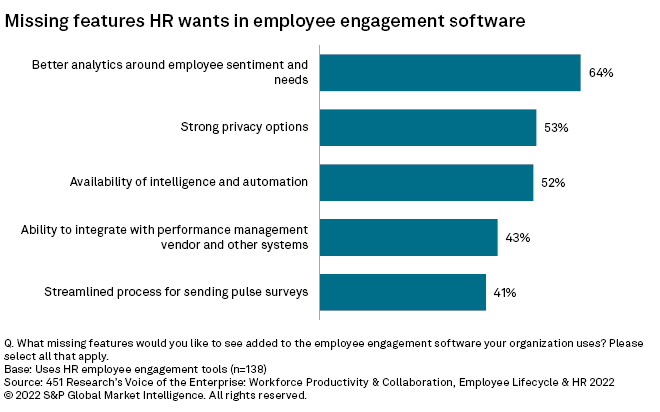S&P Global Offerings
Featured Topics
Featured Products
Events
S&P Global Offerings
Featured Topics
Featured Products
Events
S&P Global Offerings
Featured Topics
Featured Products
Events
S&P Global Offerings
Featured Topics
Featured Products
Events
Corporations
Financial Institutions
Banking & Capital Markets
Economy & Finance
Energy Transition & Sustainability
Technology & Innovation
Podcasts & Newsletters
Corporations
Financial Institutions
Banking & Capital Markets
Economy & Finance
Energy Transition & Sustainability
Technology & Innovation
Podcasts & Newsletters
Research — 10 Aug, 2022
Introduction
The COVID-19 pandemic forced many businesses to adopt remote and hybrid work models to stay open while maintaining social distancing. This was a new approach for many organizations, involving struggles with workforce management, communications and collaboration, and employee productivity, among other issues.
However, the friction was not just a short-term issue. According to 451 Research's Voice of the Enterprise: Workforce Productivity & Collaboration, Technology Ecosystems 2021 survey, 68% of respondents believe it will be a somewhat (44%) or significant (24%) challenge to support a more distributed workforce over the next two years. The top five reasons for this difficulty are work-life balance, retaining employees, team building, employee burnout and keeping employees focused and aligned. These challenges will help reshape the role of human resources and reprioritize outcomes in various ways — changing long-standing responsibilities around compliance and bringing new responsibilities to light.

In the wake of COVID-19 and its pressure on remote and distributed work, HR has stepped up to the plate in a major way, helping to adapt the employee experience for an increasingly digital work environment and taking steps to help keep employees engaged and productive. As work, in some instances, becomes increasingly geographically distributed, HR as a function will continue to evolve, working with IT on this digital experience and driving engagement. However, it must account for new tax and pay compliance standards as employment crosses more disparate borders. It must also seek to understand and support cultural differences and deepen its skills as a communicator of business strategies and goals. While our research data shows areas where HR has already started this transition, a few key areas demand special attention moving forward.

The nature of compliance expands
Helping organizations maintain compliance standards has long been a core role of HR. Over the past few years, especially given the rise of people analytics, HR has been keeping a close eye on data privacy standards like the General Data Protection Regulation and California Consumer Privacy Act. According to data from our Voice of the Enterprise: Workforce Productivity & Collaboration, Employee Lifecycle & HR 2022 study, some 58% of HR departments (top response) already have a data analytics platform in use for people analytics.
The next stage of compliance's evolution will be catalyzed by recruiting and payroll. As organizations recruit across borders (especially international borders), there are specific standards for hiring that HR will need to become familiar with to support distributed recruiting. Beyond potential cultural and sociopolitical challenges, there are also additional tax issues that arise when paying across borders. This has led to growth among the global professional employer organization market, whereby professional employer organization vendors manage all these friction points in hiring internationally. Examples of vendors in this and adjacent spaces include Oyster HR Inc., Neeyamo and Papaya Global Ltd.
Closer collaboration with IT becomes critical
For remote and distributed workers, the employee experience is now primarily digital. As such, most channels through which HR and the broader business can engage with the employee are through technology. This forces HR to deepen its understanding of the organization's technology stack as a way to better understand the employee experience.
To do so, HR needs to collaborate more closely with IT. Thankfully, this is already in full swing as IT is the function area that HR collaborates with most frequently (46%), according to our Employee Lifecycle & HR survey. In that same survey, 61% of HR respondents listed HR as the function most directly involved with architecting and leading the employee experience strategy at their organization; IT was not far behind at 52%. Investing in modern, employee-driven tech stacks also supports addressing retention challenges, with 29% of the respondents to our Voice of the Enterprise: Workforce Productivity & Collaboration, Employee Engagement 2021 survey saying they would be somewhat or very willing to take a new job if the only difference from their current job was better devices, applications or productivity tools.
Employee engagement investments increase
Employee engagement is difficult enough when employees share the same office and see each other daily. The challenge in supporting this engagement is magnified when employees are geographically distributed. This is likely at least part of why the biggest investment area for HR (49%) over the next 12 months will be employee engagement tools, such as software for tracking goals, sending pulse surveys or measuring sentiment. As HR increases spending and modernizes its tools in this area, it is looking for certain key features.

DEI must be comprehensive
At the time of this writing, some 52% of HR departments have a formal commitment or program for increasing overall diversity, equity and inclusion within the workforce, according to our Voice of the Enterprise data. Furthermore, 32% are planning their DEI program, and 14% are considering a program but have no formal plans.
As organizations expand into new regions or countries, they are also expanding into new cultures and communities with potentially different standards for work, professionalism and pay. HR must educate itself on these cultures and communities to support the true inclusion of its members. Additionally, as acceptable pay differs across the globe, HR must also prepare itself for likely difficult conversations around pay equity. This is especially critical given the desires of employees. When asked what improvements they would most like to see from their HR departments, 38% of employee respondents (top response) said, "more transparency around compensation and benefits."
HR evolves as a strategic communicator of business goals
As for how HR skills have evolved over the past three years, 44% of HR respondents in our Employee Lifecycle & HR survey said they have been participating more in wider company strategy and vision. Additionally, 38% said they are now more consultative and partner more with the business. We have seen this trend in previous surveys, so it has not come out of the blue as a response to COVID-19 and remote work. How HR leverages these new skills is important for improving employee satisfaction.
When asked what change in their workplace had the most positive impact on them as employees, survey respondents mentioned the ability to work remotely as the top response (28%). The second-highest response (20%) ranked better communication of their organization's strategy and vision as the most positively impactful workplace change. As businesses settle into permanent remote and distributed work, HR must work with organizational leadership to craft compelling communications that clearly explain how broader strategy connects to work execution. Whether in the office or not, employees do not want to be left in the dark.
This article was published by S&P Global Market Intelligence and not by S&P Global Ratings, which is a separately managed division of S&P Global.
Event
